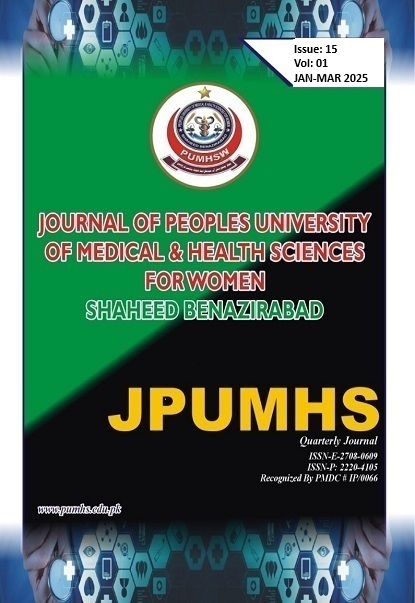HBV, HCV, AND HIV SEROPOSITIVITY: RISKS AND PREVENTION STRATEGIES.
JPUMHS; 2025:15:01,112-118. http://doi.org/10.46536/jpumhs/2025/15.01.604
Keywords:
Serology, Hepatitis B, Hepatitis C, HIV, Prevalence, Blood transfusion, Rapid diagnostic test, Infection controlAbstract
BACKGROUND: Serological testing serves as the frontline methodology for the diagnosis of
viral infections including hepatitis B virus (HBV), hepatitis C virus (HCV) and human
immunodeficiency virus (HIV) infection, especially in cases where direct identification of the
pathogen is complicated. OBJECTIVE: Public screening and health monitoring of a
population using serological assays are vital from a public health perspective since these tests
identify both current and past infections. METHODS: This cross-sectional study diagnosed
150 patients for HBsAg, anti-HCV, and HIV antigen/antibody using rapid serum
immunochromatographic lateral flow assays. Each sample was processed using the enclosed
instructions, and test lines and control lines' marking were used to conclude on results
interpretation. Stratifications were made based on sex, age, region of residence, and transfusion
history. Relations of patient attributes and infection status were studied with Chi-square tests.
RESULTS: Within the cohort of 150 patients, the prevalence rates of HBsAg and HCV were
63.3% and 42.0% respectively. There was no statistically significant difference associated with
gender for positivity of HBsAg (p = 1.00), HCV (p = 0.60), or HIV (p = 0.36). There were also
no age group associations with positivity for any of the infections (HBsAg: p = 0.50; HCV:
0.38; HIV: 0.47). Area of residence was not significantly associated with infection status for
HBsAg (p = 0.92), HCV (p = 0.57), or HIV (p = 0.21). A significant association was observed
between a history of blood transfusion and HCV positivity (p = 0.023), and borderline
association for HIV (p = 0.062); for HBsAg no significant association was noted (p = 0.20).
CONCLUSION: The investigation exposed the examined population with concerning levels
of HBV and HCV seropositivity alongside notable associations between HCV infection and a
history of blood transfusions. The study illustrates the persistent danger of transfusion-related
infections and reinforces the need for stringent blood donation protocols, enhanced infection
control measures, and intensive epidemiological surveillance. Additional studies with broader
scopes, along with deeper analyses into the factors of risk are necessary for designing effective
health policy frameworks for prevention and proactive public health responses.
Downloads
Downloads
Published
How to Cite
Issue
Section
License

This work is licensed under a Creative Commons Attribution-NoDerivatives 4.0 International License.




